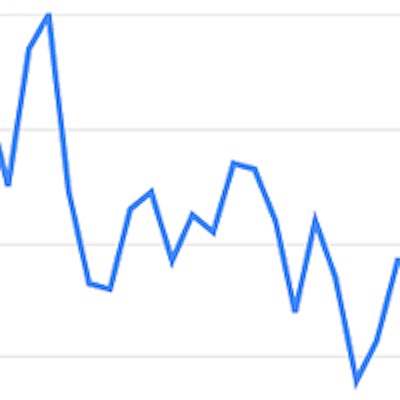
Discouraged, perhaps, by falling reimbursement and the dearth of jobs in radiology, the number of individuals performing Google searches for "radiology residency" has dropped substantially in the past several years, aligning with actual residency match data, according to researchers from Philadelphia.
The trend toward fewer radiology residency searches began in 2004, according to results from the free Google Trends service, which the researchers also dissected with their own data analysis tools. What's more, the radiology residency results were in line with the number of applications to the National Resident Matching Program (NRMP), according to the University of Pennsylvania team (Journal of the American College of Radiology, October 11, 2013).
The results also show a rapidly growing trend between 2008 and 2010 for searches of "radiology salary" -- offering clues about practitioners' top concerns. Search frequency has been "trending down precipitously since 2008 and 2009 for radiology residency, and inversely, the trend for radiology salary has been going up," said study co-author Dr. José Morey in an interview with AuntMinnie.com.
Corresponding to cuts?
The drop in residency searches corresponds to "some of the biggest cuts to radiology reimbursement," according to Morey. He completed his fellowship at the University of Pennsylvania last year and is currently a radiologist at Blue Ridge Radiologists in Fishersville, VA.
The Google Trends data are free and open for anyone to use and contribute to, Morey said. And the information has proved accurate. Previously, the data have been useful for a range of tasks from predicting interest in corrective eye surgery to eyeing the latest celebrity news and stock market trends. Google Trends has even been used to assess the severity of the upcoming flu season.
"You can catch a trend before it occurs," Morey said. For example, by analyzing spikes in the number of people Googling their flu symptoms, local healthcare providers can spot a nascent epidemic that hasn't hit the healthcare system yet.
"So we thought, what if we could use it to see if it matched up with the way people search for radiology residencies, and try to see if that matched up with NRMP data," Morey said.
Radiology, of course, has ample reason to be concerned about how many medical students are interested in careers in imaging. The looming implementation of the Patient Protection and Affordable Care Act (aka Obamacare) is expected to generate growing interest in careers in primary care medicine, to be accompanied by an increase in available scholarships. At the same time, radiology has suffered a slow avalanche of reimbursement cuts.
Radiology's fall, primary care's rise
The researchers used Google Trends to analyze searches for "radiology residency" and "radiology salary" between 2004 and April 2013. The search volume index results returned by the Google tool were then examined over time using an autoregressive integrated moving average (ARIMA) time-series analysis with JMP statistical software (version 10, SAS Institute).
"Then we correlated that by looking at the NRMP for medical practitioners to date to look at how many U.S. grads have been going into radiology," Morey said.
NRMP data showed an increase in diagnostic radiology residency positions filled by U.S. medical graduates between 2005 and 2009. But beginning in 2010, there was a dramatic decrease that continues to 2013. Google Trends also has a forecast feature, and in the case of radiology residency, it predicts a continued decline.
During the same time period, the total number of active graduates in the NRMP, which includes all allopathic and osteopathic institutions, rose by more than 5,000, from approximately 17,300 in 2004 to approximately 21,300 in April 2013.
"It started back in 2009 and goes to about 2010 when we had almost 90% of radiology positions in open residencies being fulfilled by U.S. grads, but now it's dropped down to about 75% to 80% -- and it's going in a linear distribution downward that correlates also with what we saw for the radiology residency search," Morey said.
Residency slots not filled by U.S. graduates are being filled by foreign students, whose schools have different standards than U.S. schools, he said.
Your own Google Trends search
Even without the benefit of a sophisticated ARIMA data analysis, you can see the Google Trends results yourself for "radiology residency" to date by clicking here and for "radiology salary" by clicking here. (The radiology residency search is shown below.)
Based on the data, the authors concluded that searches for radiology residency have been decreasing since 2004, continue to fall today, and will continue to fall going forward.
"We are likely to see a further loss of U.S. graduates practicing radiology," the authors wrote. "However, if cuts to reimbursement or other political headwinds continue, the trend will likely worsen, but only time and future analyses will tell."
The authors cautioned that the search volume index results from Google aren't actual numbers, and that the open system in Google Trends can be used by anyone. Therefore, there's no way to tell if medical students are the ones searching for "radiology residency," though correlation of the data with NRMP results makes it more likely.
"We need to see if the trend continues, so we'll need to do another study to follow it up," Morey said. "But as of right now, it looks like if things keep going the way they're going, the radiology residency searches keep going downward and the numbers for MDs and DOs keep going up, we're going to see an even bigger loss of community radiologists."
The trend is particularly concerning given the huge new influx of patients expected with the implementation of the Affordable Care Act, he added. But it's not surprising that things are going this way.
"I just finished fellowship last year ... and a lot of the fellows were having difficulties finding jobs," Morey said. "I think over time it's been the cuts to reimbursement -- practices seeing their cut of the pie dwindling away."



















